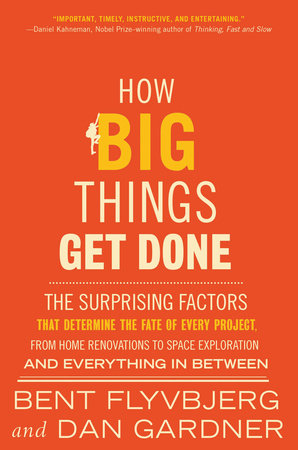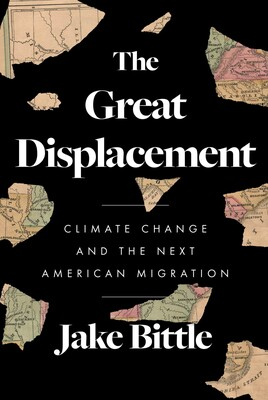Nearly every jurisdiction that has ever planned for, funded, permitted, or otherwise collaborated in a megaproject probably bears the scars of late delivery, cost overruns, broken promises, and all other manner of frustration. And, nearly every time, promoters pretend that it’s not going to happen again.
In How Big Things Get Done, Bent Flyvbjerg is putting everyone on notice.
 A professor of geography at Oxford and the IT University of Copenhagen, as well as a consultant on megaprojects, Flyvbjerg distills his research, particularly a database of several hundred megaprojects, to reveal just how inefficient big projects—the types that planners like to promote or that simply enable cities to function—can be.
A professor of geography at Oxford and the IT University of Copenhagen, as well as a consultant on megaprojects, Flyvbjerg distills his research, particularly a database of several hundred megaprojects, to reveal just how inefficient big projects—the types that planners like to promote or that simply enable cities to function—can be.
How Big Things Get Done opens with a case that is close to Californians' hearts and that puts most other boondoggles to shame: California High Speed Rail. From an original cost estimate of $33 billion, it now sits at over $100 billion. While high speed rail's final cost is nearly infinite, Flyvbjerg glibly notes that, with all projects, "there is no benefit overrun."
Flyvbjerg’s "iron law of megaprojects" holds that only 47% of projects finish on-budget; 8.5% finish on-budget and on-time; and 0.5% finish on-budget, on-time, and deliver their intended benefits. Among the most perilous categories: nuclear storage, Olympic Games, dams, and information technology projects. Projects friendly to urban planners, like bus rapid transit, rail, and buildings don’t fare much better.
Whether they serve the public sector or private sector, they all have over a 70% chance of cost overruns. And “over-budget” doesn’t mean a dollar or two. In many cases, overages reach 50% or 100% of a project’s original budget.
This is why we can't have nice things. Or, rather, this is why we can't have nicer, cheaper, and more timely nice things.
 But, forget about "nice." The advent of social upheaval and mass migration due to climate change—which is the subject of another new book, The Great Displacement: Climate Change and the Next American Migration, by Jake—make Flyvbjerg’s findings all the more urgent.
But, forget about "nice." The advent of social upheaval and mass migration due to climate change—which is the subject of another new book, The Great Displacement: Climate Change and the Next American Migration, by Jake—make Flyvbjerg’s findings all the more urgent.
Many megaprojects try to, literally, reinvent the wheel. "The main reason that projects underperform" is that designers and contractors treat, and promote, them as "unique" rather than as a member of a class. Lessons of the past go unheeded.
Designers and contractors who work on megaprojects also don't plan carefully enough. Inexperienced contractors who bid on projects end up out of their depth. They favor "action" over "thinking," to paraphrase Flyvbjerg's favorite economist-psychologist, Daniel Kahneman. They start construction too soon and assume that mishaps ("black swans") are rare when, in fact, "when delivery takes decades, the unpredictable becomes inevitable."
Flyvbjerg's object lessons include the Sydney Opera House, the Øresund road and rail bridge between Copenhagen and Malmo, Sweden; a rail tunnel between Hong Kong and the Chinese mainland; and a nuclear power plant in Japan that was completed but never turned on. (You wonder whether he's aware of the $6.4 billion debacle that is the east span of the Bay Bridge.) Flyvbjerg includes a disastrous kitchen renovation in Brooklyn for good measure. If losing $100 billion on a high-speed rail line is a statistic, losing $1 million on cabinetry is a tragedy.
(How Big Things Get Done is co-written by journalist Dan Golden, but the expertise and editorial voice clearly belong to Flyvbjerg, so much so that the text refers to "I" rather than "we." Golden, presumably, deserves the credit for making a dry subject unusually engaging.)
Projects that fare better include, in order of predictability, solar farms, wind farms, power lines, roads, and pipelines. Each benefits from what Flyvbjerg describes as "modularity." They are not large projects; they are dozens, or hundreds, of small projects built mile-by-mile or windmill-by-windmill.
He praises Heathrow Airport's Terminal 5, in which a veteran contracting team generated an unusually high sense of morale to deliver the project by an immovable deadline. Perhaps incongruously, he credits Pixar and Amazon, both of which spend time on actions that are reversible (storyboarding and strategizing, respectively) before committing to anything that's difficult or impossible to fix. He gushes over Frank Gehry’s Guggenheim Bilbao but ignores less successful Gehry projects like Disney Hall (cost overruns) or MIT’s Stata Center (leaks).
Why does all of this waste happen? Why it is allowed to happen?
On these questions, Flyvbjerg is too timid. In passing, he suggests that if designers and contractors didn't deflate their cost estimates, nothing would ever get approved. Flyvbjerg also acknowledges that public officials like to initiate legacy projects—and are rarely held to account when things go wrong years later. Both are compelling suggestions, and surely true. But Flyvbjerg fails to pursue them in the depth they deserve.
Whatever the book's shortcomings are, it serves an important purpose for planners, clients, contractors, and watchdogs alike. Nobody who is even dimly aware of How Things Big Things Get Done can so much as glance at a cost estimate or black-slapping promise without being circumspect.
Flyvbjerg cites estimates that up to $22 trillion per year is spent, collectively, on megaprojects. "If the dismal record…was improved even a little—by cutting the cost a mere 5 percent, say—$300 billion to $400 billion would be saved per year," he writes. "These are world-changing numbers."
Especially now.
I read How Big Things Get Done shortly after reading Displacement, by journalist Jake Bittle, which describes the type of geographic displacement that the early effects of climate change are causing and foretells the dramatic impacts of climate change a few decades from now.
The connection between the two books is chilling.
Bittle's chapters cover sea level rise in Florida, coastal erosion in Louisiana, drought in Arizona, and wildfires in California. Many of these stories have been told before; there are few surprises. Biddle, though, deserves credit for telling them vividly and exactingly, and with appropriate levels of alarm.
His final chapter, though speculative, should give planners pause. It's entitled "Where Will We Go?" and he means it. "By the middle of the century," Bittle writes, "housing displacement will be the most visible and ubiquitous consequence of climate change." Dramatically, he notes that localized impacts like coastal erosion will pale in comparison to "the threat of extreme heat: as the temperature shifts northward, entire states and regions will have to adjust."
Major projects, and many of them, are going to be required both to mute the effects of climate change in vulnerable places and to accommodate the migrants in resilient places.
Planners will need to figure out whether they work in a jurisdiction from which people are likely to flee or in which they are likely to seek refuge. To the latter point, "the most climate-resilient cities will be situated in temperate environments, insulated from rising seas, and possessed of ample fresh water." Biddle centers these characteristics around the Great Lakes, predicting that many Rust Belt cities must plan to absorb populations they could only dream of just a generation ago. In those places, we will need levees and seawalls; wind farms and solar arrays; hospitals; nuclear power plants; and all sorts of urban infrastructure.
"In our present situation," writes Flyvbjerg, "wasted resources and wasted time are a threat to civilization."
How Big Things Get Done: The secrets to successfully planning and delivering projects on any scale—from home renovations to space exploration and everything in between
By Bent Flyvbjerg and Dan Gardner
Hardcover $28.99
Currency Press
Feb 07, 2023
304 Pages
The Great Displacement: Climate Change and the Next American Migration
By Jake Bittle
Simon & Schuster
February 21, 2023
368 pages
Hardcover: $28.99

